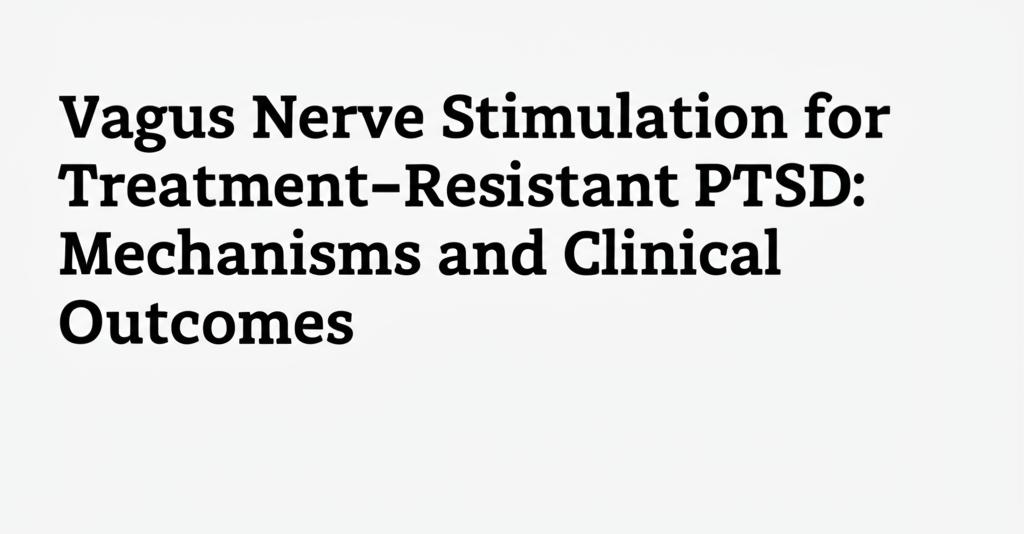Vagus Nerve Stimulation (VNS) is showing promise as a potential adjunctive therapy for individuals with treatment-resistant Post-Traumatic Stress Disorder (PTSD). This approach involves stimulating the vagus nerve, a key component of the parasympathetic nervous system, which helps regulate a wide array of crucial bodily functions, including mood, heart rate, digestion, and the "fight-or-flight" stress response.
Mechanisms of Action:The precise ways VNS may alleviate PTSD symptoms are still under investigation, but research points to several potential mechanisms:
- Modulation of the Autonomic Nervous System: PTSD is often characterized by sympathetic nervous system hyperarousal (the "fight-or-flight" response). VNS activates the parasympathetic nervous system, which can counteract this hyperarousal, leading to a calming effect on the body and mind. It's thought to restore a healthier balance between the sympathetic and parasympathetic systems.
- Enhanced Extinction Learning: Individuals with PTSD often struggle to extinguish conditioned fear responses. VNS is believed to promote neural plasticity, particularly when paired with exposure-based therapies. This means it may help the brain form new, non-traumatic associations with triggers, essentially "rewiring" fear circuits. Animal models suggest VNS can enhance the consolidation of extinction memories, making them more robust and less susceptible to relapse.
- Neurochemical Changes: VNS can influence the release of key neurotransmitters in the brain. It has been shown to increase levels of norepinephrine and serotonin, which play roles in mood, learning, and memory. In individuals with PTSD, increased norepinephrine in limbic regions (brain areas involved in emotion and memory) may improve extinction learning.
- Anti-inflammatory Effects: Chronic stress and PTSD are associated with increased inflammation in the body. VNS has demonstrated anti-inflammatory properties, potentially by reducing the production of pro-inflammatory cytokines like Interleukin-6 (IL-6) and Interferon-gamma (IFNγ). This reduction in inflammation may contribute to the therapeutic benefits observed in PTSD.
- Modulation of Brain Activity: Neuroimaging studies suggest VNS can modulate activity in brain regions crucial for regulating mood and emotion, such as the prefrontal cortex, amygdala, and hippocampus. These areas are often dysregulated in PTSD.
- HPA Axis Interaction: The hypothalamic-pituitary-adrenal (HPA) axis is a central stress response system. VNS may interact with and help regulate HPA axis function, which can be disrupted in PTSD.
While much of the initial evidence comes from animal studies, human research, including clinical trials, is growing and showing encouraging results:
- Symptom Reduction: Studies, including randomized controlled trials, have reported significant reductions in PTSD symptoms in patients receiving VNS, particularly non-invasive forms like transcutaneous VNS (tcVNS), compared to sham (placebo) treatments. These improvements have been observed in clinician-administered PTSD scales and self-reported symptom checklists.
- Improved Physiological Responses to Stress: tcVNS has been shown to reduce sympathetic nervous system responses (like heart rate increases) during exposure to traumatic stress reminders in individuals with PTSD. It can also lead to increases in parasympathetic activity.
- Long-Term Benefits: Some studies suggest that the benefits of VNS paired with therapy can be lasting. A recent Phase 1 clinical trial reported that patients with treatment-resistant PTSD were symptom-free up to six months after completing traditional prolonged exposure therapy combined with VNS. In this study, all participants reportedly lost their PTSD diagnosis after treatment.
- Non-Invasive Options: The development of non-invasive VNS (nVNS) devices, such as those that stimulate the vagus nerve through the skin on the neck (cervical VNS or tcVNS) or the ear (auricular VNS or taVNS), has made this therapy more accessible and less risky than surgically implanted devices. These nVNS devices are being actively investigated and are showing promise. Some nVNS devices have received Breakthrough Device Designation from the FDA for PTSD, indicating their potential.
- Safety and Tolerability: Non-invasive VNS is generally considered safe with minimal side effects. Implanted VNS, approved for treatment-resistant depression and epilepsy, carries the risks associated with a surgical procedure.
- Ongoing Research: Despite positive findings, more large-scale, rigorous randomized controlled trials are needed to firmly establish the efficacy of VNS for PTSD and to determine optimal stimulation parameters and patient populations who would benefit most. Current research continues to explore the precise neurobiological mechanisms and to compare different VNS delivery methods.
It's important to note that while VNS is a promising avenue, it is not yet a standard, widely adopted treatment specifically for PTSD, and its use is often considered for treatment-resistant cases where other therapies have not been effective. The research landscape is rapidly evolving, with new findings continually emerging.

